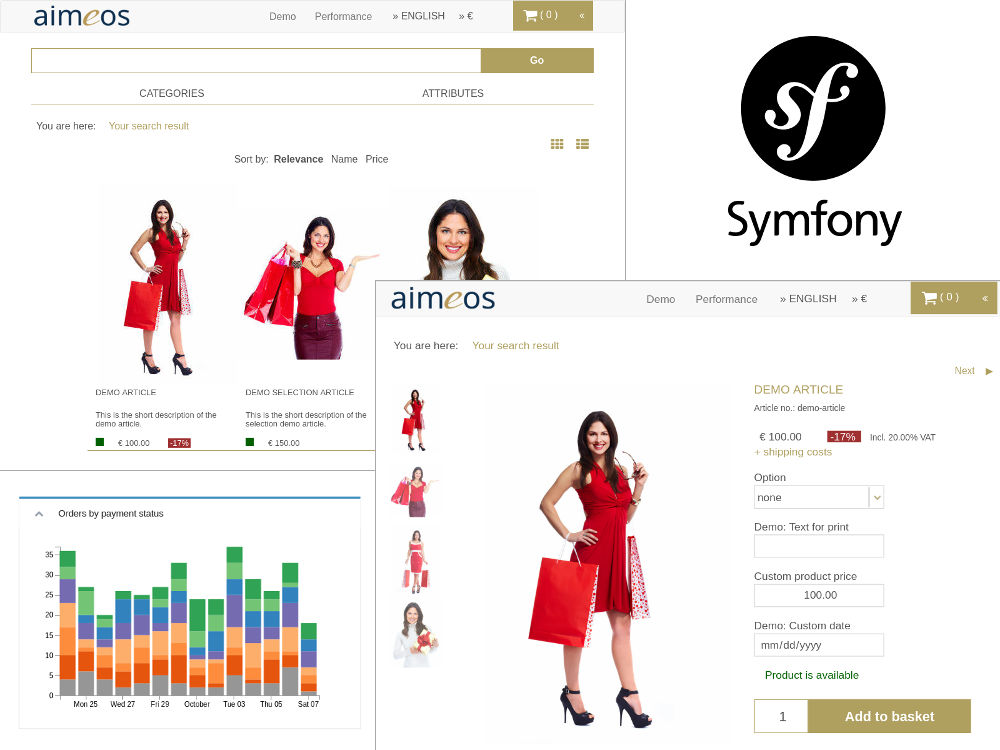Aimeos Symfony bundle
The repository contains the Symfony e-commerce bundle integrating the Aimeos e-commerce library into Symfony 2 and 3. The bundle provides controllers for e.g. faceted filter, product lists and detail views, for searching products as well as baskets and the checkout process. A full set of pages including routing is also available for a quick start.
Table of content
Installation
This document is for the latest Aimeos Symfony beta release, for production there's a stable/LTS release.
The Aimeos Symfony e-commerce bundle is a composer based library that can be installed
easiest by using Composer. Before, the Aimeos bundle class
must be known by the registerBundles() method in the app/AppKernel.php file so the
composer post install/update scripts won't fail:
$bundles = array(
new Aimeos\ShopBundle\AimeosShopBundle(),
...
);
Make sure that the database is set up and it is configured in your config.yml. Then add these lines to your composer.json of your Symfony2 project:
"prefer-stable": true,
"minimum-stability": "dev",
"require": {
"aimeos/aimeos-symfony": "~2016.01",
...
},
"scripts": {
"post-install-cmd": [
"Aimeos\\ShopBundle\\Composer\\ScriptHandler::installBundle",
"Aimeos\\ShopBundle\\Composer\\ScriptHandler::setupDatabase",
...
],
"post-update-cmd": [
"Aimeos\\ShopBundle\\Composer\\ScriptHandler::installBundle",
"Aimeos\\ShopBundle\\Composer\\ScriptHandler::setupDatabase",
...
]
}
Afterwards, install the Aimeos shop bundle using
composer update
In a production environment or if you don't want that the demo data gets installed, use the --no-dev option:
SYMFONY_ENV=prod composer update --no-dev
Note: Alternatively to running the post-install-cmd and post-update-cmd
scripts automatically, you can add the lines required for installing the bundle
manually. In your ./app/config/config.yml file you need to add "AimeosShopBundle"
to the list of bundles managed by the assetic bundle:
assetic:
# ...
bundles: ['AimeosShopBundle']
Furthermore, add the Aimeos routes to your ./app/config/routing.yml
aimeos_shop:
resource: "@AimeosShopBundle/Resources/config/routing.yml"
prefix: /
For setting up the database, please run the following commands afterwards:
php app/console aimeos:setup
php app/console aimeos:cache
Finally, create the ./web/uploads/ directory and make sure it's writeable by the web server:
mkdir ./web/uploads/
chmod 777 ./web/uploads/
In your production environment, you should use these commands as root instead:
mkdir ./web/uploads/
chmod 755 ./web/uploads/
chown www-data:www-data ./web/uploads/
Setup
To see all components and get everything working, you also need to adapt your
Twig base template in app/Resources/views/base.html.twig. This is a working
example using the Twitter bootstrap CSS framework:
<!DOCTYPE html>
<html>
<head>
<meta charset="UTF-8" />
<meta http-equiv="X-UA-Compatible" content="IE=edge">
<meta name="viewport" content="width=device-width, initial-scale=1">
{% block aimeos_header %}{% endblock %}
<title>{% block title %}Aimeos shop{% endblock %}</title>
<link rel="icon" type="image/x-icon" href="{{ asset('favicon.ico') }}" />
<link href="https://maxcdn.bootstrapcdn.com/bootstrap/3.3.2/css/bootstrap.min.css" rel="stylesheet">
{% block aimeos_styles %}{% endblock %}
</head>
<body>
<div class="navbar navbar-static" role="navigation">
<div class="container">
<div class="navbar-header">
<button type="button" class="navbar-toggle collapsed" data-toggle="collapse" data-target=".navbar-collapse">
<span class="sr-only">Toggle navigation</span>
<span class="icon-bar"></span>
<span class="icon-bar"></span>
<span class="icon-bar"></span>
</button>
</div>
</div>
{% block aimeos_head %}{% endblock %}
</div>
<div class="col-xs-12">
{% block aimeos_nav %}{% endblock %}
{% block aimeos_stage %}{% endblock %}
{% block aimeos_body %}{% endblock %}
{% block aimeos_aside %}{% endblock %}
</div>
<script src="https://code.jquery.com/jquery-1.11.2.min.js"></script>
<script src="https://code.jquery.com/jquery-migrate-1.2.1.min.js"></script>
<script src="https://maxcdn.bootstrapcdn.com/bootstrap/3.3.2/js/bootstrap.min.js"></script>
{% block aimeos_scripts %}{% endblock %}
</body>
</html>
Start the PHP web server in the base directory of your application to do some quick tests:
php -S 127.0.0.1:8000 -t web
Then, you should be able to call the catalog list page in your browser using
http://127.0.0.1:8000/app_dev.php/list
Admin
Setting up the administration interface is a matter of configuring the Symfony firewall to restrict access to the admin URLs.
Caution: If you forget the protect the URLs of the administraiton interface, everybody will be able to change or delete any content in your shop!
A basic firewall setup in the ./app/config/security.yml file can look like this one:
security:
providers:
admin:
memory:
users:
admin: { password: secret, roles: [ 'ROLE_ADMIN' ] }
in_memory:
memory: ~
encoders:
Symfony\Component\Security\Core\User\User: plaintext
firewalls:
aimeos_admin:
pattern: ^/(admin|extadm|jqadm|jsonadm)
anonymous: ~
provider: admin
form_login:
login_path: /admin
check_path: /admin_check
main:
anonymous: ~
access_control:
- { path: ^/(extadm|jqadm|jsonadm), roles: ROLE_ADMIN }
These settings will protect the /extadm (ExtJS), the /jqadm (JQuery+Bootstrap)
and /jsonadm (JSON API) URLs from unauthorized access from someone without
admin privileges. There's only one user/password combination defined, which is
rather inflexible. As alternative, you can use on of the other Symfony user provider
to authenticate against.
Caution: The order of the configuration settings in this file is important!
If you place the in_memory or main section before the Aimeos related sections,
authentication will fail!
A bit more detailed explanation of the authentication is available in the Aimeos docs
Hints
To simplify development, you should configure to use no content cache. You can do this in the ./app/config/config_dev.yml file of your Symfony application by adding these lines:
aimeos_shop:
classes:
cache:
manager:
name: None
License
The Aimeos Symfony bundle is licensed under the terms of the MIT license and is available for free.

